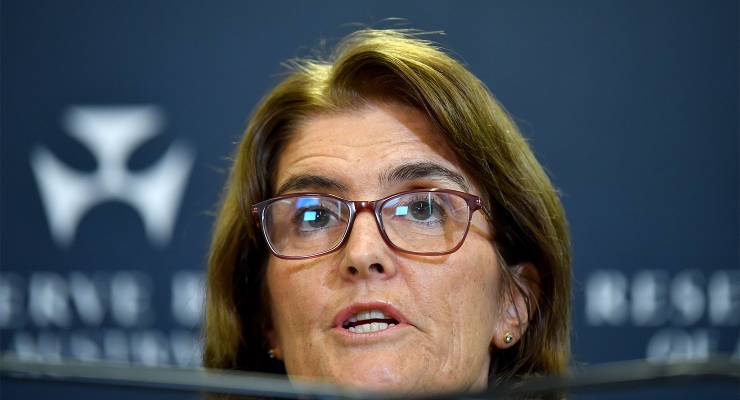
Well, plus ça change — the new era of Reserve Bank meetings and post-meeting communication, which opened to glowing and often facile reviews from the mainstream media, sounds a lot like the old era.
In the last meeting under the old RBA board regime in December, governor Michele Bullock’s post-meeting statement mentioned inflation 22 times. Yesterday’s statement managed 23. That’s despite the big fall in inflation in the December quarter — oh, and despite the bank materially reducing its inflation forecasts in its February statement of monetary policy (SMP), released (sensibly) at the same time as the meeting statement.
Back in November, Bullock and her forecasts thought inflation would still be 3.5% by the year’s end. Now it’s expected to be 3.2%. GDP growth was expected to be 2%; now it’s 1.8%. Household consumption was expected to be 2.1%, now it’ll be 1.7%. Unemployment was expected to rise to 4.2%, now it’s 4.3%. Its forecasts for what happened in the December quarter last year have also been revised downward.
The RBA thinks the economy has materially softened, but Bullock is banging on about inflation more than ever. There also remain big questions over our major economic driver, China. “There also remains a high level of uncertainty around the outlook for the Chinese economy,” the SMP noted — which may yet make 2024 even gloomier.
It’s now clear that the RBA’s rate rise in November, after appearing to pause rate hikes after the last rise in June, was not merely wholly unnecessary but actively damaged the economy for no benefit except to the inflation galahs that feast off the misery of ordinary Australians. And as Michael Pascoe pointed out, Bullock isn’t done with punishing families with mortgages — the bite that higher interest rates take out of incomes will continue to increase as those of us with fixed-rate mortgages reach the end of their fixed period and jump up to the variable rate.
The SMP and Bullock’s post-meeting statement might yet lay the groundwork for Bullock keeping interest rates punitively high for much longer despite rapidly falling inflation. The statement includes a truly weird forecast that labour productivity is about to surge from its current negative level to 3% by June and then settle at just over 1% annually by the year’s end.
Where, exactly, is this dramatic surge going to come from? Not from the mining sector, which exercises a hugely outsized role in national productivity data — we’re seeing nickel and lithium prices plunging, which will nix the expected investment surge there. Maybe from agriculture? El Niño has been much wetter than expected, but that merely means a big hit to agricultural production hasn’t materialised. We’re certainly not about to revert to a manufacturing economy, given the speed with which our health and caring sectors are expanding. Australians are already working the longest hours they ever have. Maybe the increase in unemployment will help?
What happens when this expected productivity boost fails to show up? Bullock said in her statement that wages growth was OK as long as productivity returns to its long-run average. But as we’ve written time and again, Bullock and the RBA appear mystified about productivity and remain stuck in a world where you only had to sack a few workers and cut company tax for productivity to magically rise.
The whole thing — the decision, the statements, the media conference, the monomania about inflation — have the air of a theatre production in which a chattering elite pat themselves on the back for how clever they are, while ordinary Australians deal with the consequences of their poor decisions.









Elsewhere in Crikey, Bernard Keane has a good article about corporate profiteering driving inflation.
If the RB were serious, they would join with the ACCC to force some old-fashioned trust-busting.
A breakup of Coles, Woolworths, Qantas, Telstra?
A clearer path for investors to set up rival supermarket chains, energy providers, telcos?
That is how to fight inflation, not old-fashioned interest rate levers.
I suspect the real obsession is with making sure labour never regains any bargaining power.
Productivity is low because workers are still demoralised by the 9 years of wage freeze imposed by a combination of the coalition, the FWC and the APSC – Australian Public service head. Australians are working longer hours than ever. Low productivity reflects this demoralised state. We are yet to see real wage increases on an annual basis. We still have the Fair Work Act and the Fair Work Commission – not an industrial court. Low productivity is something you do in lieu of industrial action. Simple as that. I jumped ship when I knew my department was training me up on technical tasks so I could be used and abused to make my superiors’ life easier. I stalled for as long as I could, passed the courses and after a month or so, retired. It pays sometimes to be old.
Oh, gosh and gee whiz, I really thought that all our financial troubles were well and truly over when Phillip Lowe was replaced as Governor of the Reserve Bank. Now wasn’t I a bit on the naive side?! I mean who would have thought that nothing of any significance would change after he went?
I never did. I knew that to get decent monetary policy you would have to abolish the RBA, sack the board, reconvene a new monetary policy instrument or body and populate this body with people with more than just executive management experience or free market lobby groups or free tank experience. You need people with a thorough grip on monetary policy and economic theory. You need more academics, unionists and even a nominal citizen or 2 – like a jury.
Poor old savers, a brief moment of decent rates soon to come to an end.